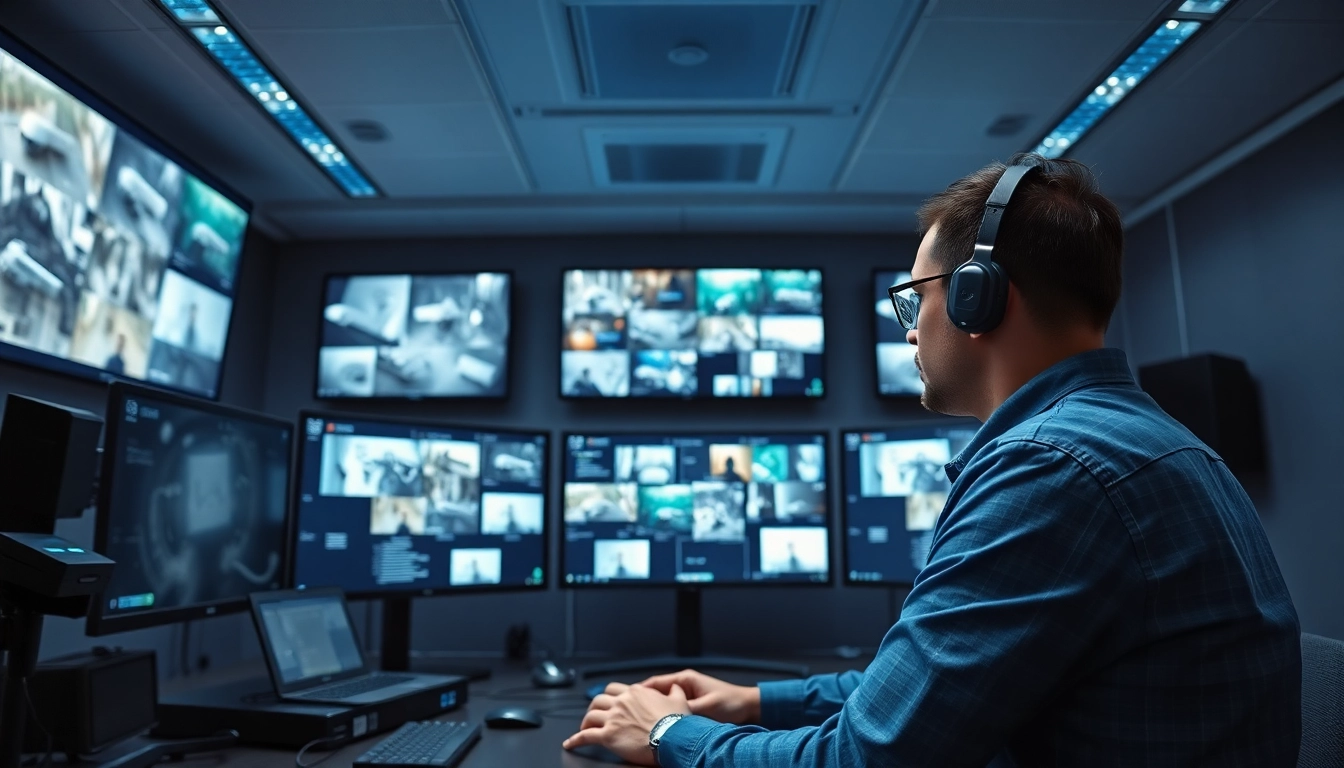Understanding the Basics of CCTV & Remote Monitoring
What Is CCTV & Remote Monitoring?
Closed-circuit television (CCTV) systems have undergone significant evolution since their introduction. Today, they encompass a range of technologies that allow for real-time video surveillance and recording of activity within specified areas. CCTV & Remote Monitoring combine these systems with advanced monitoring capabilities, enabling operators to access live feeds and recorded footage remotely via the internet. This integration provides unparalleled versatility and ensures that security management is no longer confined to physical locations.
Essentially, CCTV & Remote Monitoring are about creating a safe environment. Rather than just recording events, these systems facilitate immediate responses to incidents, thereby enhancing overall security measures. By leveraging the power of the internet, organizations can monitor their premises from virtually anywhere, increasing both safety and situational awareness.
Core Components of a CCTV System
A typical CCTV system consists of several key components, each playing a crucial role in the overall functionality:
- Cameras: These are the backbone of any CCTV system, capturing video footage. Cameras may include various types, such as dome, bullet, or PTZ cameras, each serving distinct purposes depending on the environment.
- Digital Video Recorder (DVR) or Network Video Recorder (NVR): These devices store the video footage for later review. DVRs are used with analog systems, while NVRs are used with IP cameras.
- Monitors: Monitors display the live footage captured by the cameras, allowing for real-time observation.
- Power Supply: Reliable power is essential for maintaining uninterrupted operation of the CCTV system.
- Networking Equipment: For remote monitoring, networking equipment like routers and switches is crucial for connecting the system to the internet.
Advantages of CCTV & Remote Monitoring
Utilizing CCTV & Remote Monitoring provides numerous advantages:
- 24/7 Surveillance: Continuous monitoring ensures that your premises are under constant observation, making it difficult for potential intruders to operate undetected.
- Remote Accessibility: Users can access live feeds and recorded footage from anywhere in the world, enabling swift responses to incidents.
- Deterrent Effect: The mere presence of CCTV systems can deter criminal activity, as potential offenders are aware they are being watched.
- Improved Incident Documentation: Recorded footage can be invaluable for investigations and insurance claims, providing concrete evidence of events that transpired.
- Integration with Other Security Systems: CCTV can work in tandem with alarms and access control systems for a comprehensive security solution.
Choosing the Right CCTV Systems for Your Needs
Types of CCTV Cameras Available
Selecting the right type of CCTV camera is vital for ensuring effective monitoring. Here are common types:
- Dome Cameras: These are typically used indoors and can be mounted on walls or ceilings. They offer a discreet design and can capture footage at various angles.
- Bullet Cameras: Ideal for outdoor use, bullet cameras have a more noticeable presence and are often equipped with infrared technology for night vision.
- PTZ Cameras: Pan-Tilt-Zoom (PTZ) cameras can be remotely controlled to pan, tilt, and zoom in on specific areas, providing versatile coverage.
- IP Cameras: These digital cameras transmit data over the internet, allowing for higher resolution footage and easier remote access.
- Thermal Cameras: Utilizing infrared technology, thermal cameras can detect body heat, making them effective in low-light conditions.
Considerations for System Selection
Choosing the right CCTV system depends on various factors:
- Location: Assess whether the installation will be indoors, outdoors, or a combination of both, as this will determine the types of cameras required.
- Coverage Area: Map out the area that needs monitoring to understand how many cameras are needed and their optimal placement.
- Resolution: Higher resolution cameras provide clearer images, which can be critical in identifying individuals or details in footage.
- Storage Capacity: Consider how much footage you need to keep and for how long, which will dictate the type of recording device and its capacity.
- Budget: Set a budget that allows for equipment, installation, and ongoing maintenance of the system.
Evaluating Local Installation Providers
When it comes to installing a CCTV system, selecting a reliable provider is paramount. Consider these aspects when evaluating local installation services:
- Experience: Look for providers with a proven track record in CCTV installations. Customer testimonials and case studies can provide insight into their expertise.
- Licensing and Insurance: Verify that the service providers have the necessary licenses and insurance, which is crucial for safeguarding your investment.
- Customization: A reputable provider should be able to tailor the system to your specific needs, rather than offering one-size-fits-all solutions.
- Support and Maintenance: Evaluate if the provider offers ongoing support and maintenance, which can enhance the longevity and performance of your system.
Setting Up Your CCTV & Remote Monitoring System
Installation Step-by-Step Guide
Installing a CCTV & Remote Monitoring system entails several steps:
- Planning: Assess your security needs and plan out camera locations and angles for optimal coverage.
- Wiring: Run necessary cables for power and data to all camera locations. Wireless options are also available but may have limitations.
- Mounting Cameras: Securely mount each camera in the predetermined locations, ensuring they are positioned for maximum effectiveness.
- Connecting to DVR/NVR: Hook up the cameras to the DVR or NVR, ensuring proper configuration.
- Testing: Before finalizing, test the system to ensure all cameras are functioning properly and feeding images back to the recording equipment.
- Final Configuration: Set recording schedules, motion detection settings, and remote access protocols according to your needs.
Optimal Camera Placement for Maximum Coverage
Strategic camera placement is vital for effective surveillance. Key guidelines include:
- Entry Points: Install cameras covering all points of entry and exit, including doors and windows.
- High Traffic Areas: Position cameras in areas with frequent activity to capture important footage.
- Blind Spots: Identify and eliminate blind spots in your coverage. Adjust camera angles and use multiple cameras if necessary.
- Lighting Conditions: Be aware of lighting conditions in each area to select cameras with appropriate capabilities, such as infrared for low light.
Connecting to Remote Monitoring Platforms
Once the physical installation is complete, connecting your CCTV to remote monitoring platforms allows for live access:
- Internet Configuration: Ensure your CCTV system is connected to a stable internet connection for streaming footage remotely.
- Mobile Application: Most modern systems come with mobile apps. Download these applications and link them to your CCTV system for convenience.
- Security Protocols: Implement security measures like password protection and two-factor authentication to safeguard access to your system.
Best Practices for Effective Monitoring
Protocols for Live Monitoring
Establishing protocols for live monitoring ensures incidents are handled efficiently:
- Regular Monitoring Schedules: Set specific times for team members to check live feeds, rather than relying on occasional checks.
- Incident Reporting: Develop a system for documenting and reporting incidents observed during monitoring sessions.
- Staff Training: Ensure staff members are trained to use the system effectively and know how to respond to alerts and alarms.
Recording and Storing Video Footage
How you record and store footage can affect your system’s efficiency:
- Retention Policy: Define how long footage will be stored based on compliance and organizational needs. Ensure appropriate storage capacity is available.
- Secure Storage Solutions: Use secure, encrypted storage solutions to protect recorded data from unauthorized access.
- Regular Backups: Implement a plan for regularly backing up footage stored on digital devices to prevent data loss.
Responding to Alerts and Incidents
A proactive approach is necessary for responding to potential threats:
- Instant Notifications: Configure your system to send real-time alerts for suspicious activities.
- Action Plans: Develop clear action plans that outline the steps to be taken in response to alerts. This can range from contacting law enforcement to implementing on-site protocols.
- Post-Incident Reviews: After any incident, conduct reviews to evaluate the response and identify areas for improvement.
Evaluating Performance and ROI of CCTV & Remote Monitoring
Key Performance Metrics to Track
Measuring the performance of your CCTV & Remote Monitoring system is essential for ensuring it meets security objectives:
- Footage Quality: Regularly assess the quality of captured footage to ensure clarity and reliability for identification purposes.
- System Uptime: Track the system’s operational time to identify any downtimes that could compromise security.
- Incident Frequency: Analyze the number of incidents over time to understand if the system is effectively deterring criminal activities.
Assessing Incident Reports and Feedback
Incident reports are crucial for learning and improving your security setup:
- Documentation: Keep comprehensive records of all incidents, including the response taken. This data can inform future decisions and improvements.
- Feedback Mechanism: Establish a system for collecting feedback from staff who monitor the system on any challenges faced or suggestions for enhancements.
Improving System Efficiency Over Time
Continuous improvement is key to maintaining an effective CCTV & Remote Monitoring system:
- Regular Audits: Conduct periodic audits of your system and processes to ensure everything is functioning as intended and remains up-to-date.
- Adapt to New Technologies: Stay informed about technological advancements in CCTV and remote monitoring to enhance system capabilities where feasible.
- Training Updates: Regularly refresh staff training to accommodate new systems or procedures and reinforce best practices.




